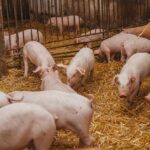When engaging in cattle farming in South Africa, it’s important to be aware of various infections and diseases that can affect cattle. These diseases can have significant economic impacts on the industry if not properly managed. Here are some common infections and diseases to watch out for:
- Foot-and-Mouth Disease (FMD):
FMD is a highly contagious viral disease that affects cloven-hoofed animals, including cattle. It causes fever, blisters on the tongue, lips, and feet, and can result in lameness. FMD outbreaks can lead to significant trade restrictions. - Bovine Tuberculosis (bTB):
Bovine tuberculosis is a chronic bacterial disease that primarily affects cattle but can also infect other animals and humans. It is characterized by weight loss, chronic coughing, and the formation of tubercles in organs. Regular testing and culling of infected animals are important to control bTB.- Brucellosis:
Brucellosis is a bacterial disease that can be transmitted from animals to humans (zoonotic). It primarily affects reproductive organs, causing abortion, stillbirths, and infertility in cattle. Control measures include testing, culling, and vaccination.
- Brucellosis:
- Anthrax:
Anthrax is a zoonotic bacterial disease that can affect a wide range of animals, including cattle. It is characterized by sudden death and the presence of blood-stained discharge from body openings. Vaccination and proper disposal of carcasses can help prevent the spread of anthrax. - Tick-borne Diseases:
South Africa is known for its diverse tick species that can transmit various diseases, such as babesiosis (redwater), anaplasmosis, and heartwater. These diseases cause anemia, fever, and can be fatal if not treated promptly. Tick control measures, including acaricide application, are crucial. - Lumpy Skin Disease (LSD):
LSD is a viral disease transmitted by biting insects, primarily affecting cattle. It causes fever, nodules on the skin, and can lead to severe production losses. Vaccination and insect control are important strategies for LSD prevention. - Theileriosis:
Theileriosis, also known as tropical theileriosis or January disease, is a tick-borne disease caused by the parasite Theileria parva. It causes high fever, anemia, and can be fatal. Tick control and vaccination are essential preventive measures. - Blackleg:
Blackleg is a bacterial disease caused by Clostridium chauvoei. It is characterized by sudden death, lameness, and swelling in the affected muscle areas. Vaccination and good management practices, such as proper hygiene and avoiding injury during vaccination, can help prevent blackleg.
It’s crucial to work closely with local veterinarians and agricultural extension services to implement appropriate prevention and control measures, including vaccination programs, regular testing, quarantine protocols, and good farm biosecurity practices. Early detection, rapid response, and appropriate treatment or culling of infected animals are key to minimizing the impact of diseases on cattle farming operations.
Join 'Farmers Mag' WhatsApp Channel
Get the latest Farming news and tips delivered straight to your WhatsApp
CLICK HERE TO JOIN






